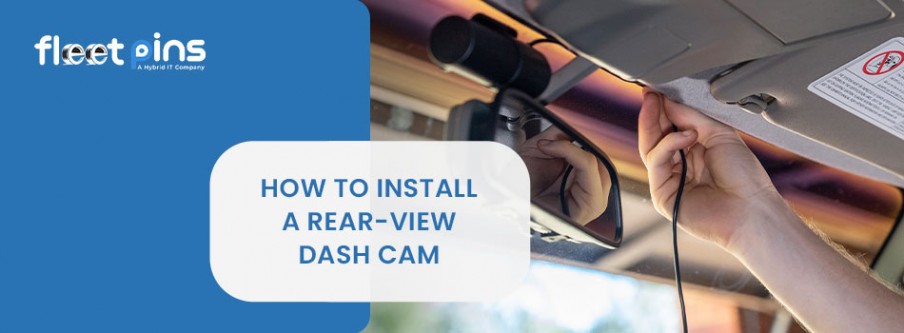
- On 2024-10-15
How to Install a Rear-View Dash Cam: A Step-by-Step Guide
Installing a rear-view dash cam can significantly enhance your vehicle's safety by providing continuous monitoring of the road behind you. It records footage that can serve as evidence in case of accidents, protect against insurance fraud, and monitor your surroundings when parked. Fleet Pins will walk you through the step-by-step process of installing a rear-view dash cam, ensuring that you do it correctly and safely.
Why Install a Rear-View Dash Cam?
Before diving into the installation process, it's important to understand the benefits of a rear-view dash cam. These devices record everything that happens behind your vehicle, which can be useful in various situations:
Accident evidence
Rear-view dash cams provide video evidence that can help resolve disputes in case of rear-end collisions or parking lot incidents.
Parking protection
They can detect motion and start recording if someone approaches or hits your car while parked.
Avoiding insurance fraud
A dash cam can capture any fraudulent activity, such as "staged" accidents where someone intentionally tries to cause a collision for an insurance payout.
You May Also Read: How Dash Cameras Impact Your Car Insurance
Tools and Materials You’ll Need
To successfully install a rear-view dash cam, make sure you have the following tools and materials:
- Rear-view dash cam kit (including the camera, cables, and mount)
- MicroSD card (for recording storage)
- Plastic trim removal tool (to hide the cables)
- The power source (cigarette lighter adapter, hardwire kit, or OBD-II adapter)
- Double-sided tape or suction cup mount (depending on your dash cam)
- Electrical tape (optional for securing loose wires)
- Cleaning cloth (for wiping down surfaces before attaching the mount)
Step-by-Step Guide to Installing a Rear-View Dash Cam
Let’s see how to wire the rear dash cam:
Step 1: Choose the Right Location for the Camera
The ideal location for a rear-view dash cam is typically the top-centre portion of the rear windshield. This placement ensures the camera has an unobstructed view of the road and captures the full width of the rear scene.
Clean the area where you plan to mount the camera using a cleaning cloth to ensure the adhesive sticks well. Avoid placing the camera in areas where it could block your view or interfere with rear defrosters.
Step 2: Mount the Rear-View Dash Cam
- Attach the camera using the provided suction cup or adhesive mount. Press firmly to ensure it sticks securely.
- Adjust the angle of the camera so it captures the road behind you. Make sure it’s not tilted too high or too low.
Step 3: Route the Power Cable
Running the power cable correctly ensures a neat installation and prevents loose wires from interfering with your driving. Here's how to do it:
Start from the camera and route the cable along the edge of the rear windshield. Tuck the cable under the vehicle's headliner using a plastic trim removal tool. Continue routing the cable down the side of the car, tucking it behind the trim panels along the door frame. Bring the cable toward the front of the car and connect it to a power source.
Step 4: Choose a Power Source
You can power your dash cam in several ways, depending on your preference:
Cigarette Lighter Adapter:
The easiest method is to use the cigarette lighter or 12V socket adapter. Simply plug in the adapter, and your dash cam will power on and off with the car’s ignition. However, this may leave visible cables inside the cabin.
Hardwire Kit:
For a cleaner installation, you can hardwire the dash cam to your vehicle's fuse box. This approach provides a seamless look and allows the dash cam to continue recording even when the car is parked (using "parking mode"). Make sure to use the fuse tap provided in the hardwire kit and choose a fuse slot that powers on and off with the ignition.
OBD-II Adapter:
An OBD-II adapter plugs into your car’s OBD-II port, usually located under the dashboard. This provides a stable power source and makes installation easier compared to hardwiring.
Step 5: Insert the MicroSD Card
Before turning on the dash cam, insert the MicroSD card for recording storage. Make sure the card is compatible with your dash cam model and has sufficient storage capacity (at least 32GB is recommended). Insert the card into the dash cam's slot until it clicks into place. Format the card using the dash cam's settings menu to ensure it's ready for recording.
You May Also Read: How to Format an SD Card for Dash Cam?
Step 6: Test the Dash Cam
After installing the rear dash cam, test the dash cam to ensure it works properly.
- Turn on the ignition to power up the dash cam.
- Check the camera's view and adjust the angle if necessary to ensure it captures the road behind you.
- Review the footage to confirm that the recording is clear and covers the entire rear view.
Tips for a Successful Installation
- A plastic trim removal tool is essential for tucking the cable neatly behind trim pieces.
- Make sure the camera doesn’t obstruct your view and is correctly aligned with the road.
- If you have any leftover cable length, bundle it up and secure it with electrical tape or a cable tie.
- Occasionally review the footage to ensure the dash cam is functioning properly and capturing clear video.
Selecting the Right Dash Cam from Fleet Pins
Choosing the right dash cam from Fleet Pins extensive range can significantly enhance the safety and efficiency of your fleet operations. Whether you need basic front-facing cameras for straightforward monitoring, dual-lens models for capturing both road and in-cab activities, or advanced multi-lens systems for comprehensive coverage, Fleet Pins offers a variety of options tailored to meet diverse needs.
Consider factors such as vehicle type, desired features, and budget to select a dash cam that not only fits your operational requirements but also provides reliable, high-quality footage for better fleet management and driver safety.
Conclusion
Installing a rear-view dash cam can greatly improve your vehicle's safety and provide valuable evidence in case of incidents. By following these steps, you can set up your dash cam easily and enjoy peace of mind on the road. Make sure to regularly check your dash cam’s functionality and settings to ensure it continues to protect you effectively.
Now that you know how to install a rear-view dash cam, you can confidently equip your vehicle with this valuable tool and drive with enhanced security.




